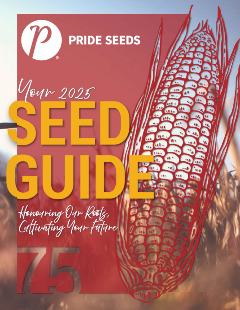Browse our selection of products below
___________________________________________________________________________________________________________________________________________

2024-2025 PRIDE Seeds Product GuideYou can find all of our products on the website, including supporting performance data and create your own personalized guide called My Guide. You can also download the digital version of our printed product guide which includes product comparison charts. |
Enhance your knowledge and stay ahead with PRIDE SEEDS Corn and Soybean School videos.
SHOP THE PRIDE SEEDS E-STORE
-7.png?sfvrsn=87920db3_3)
STAY UP-TO-DATE WITH PRIDE SEEDS LATEST BLOGS, NEWS AND ARTICLES
Corn Grain Fill, Maturity and Drydown
This article provides important agronomic information and terminology related to kernel development, maturity, and drydown. When you are scouting your fields, this will help you to know what stage your corn crop is at. The indications discussed help you determine harvest timing to maximize yield, test weight, and quality.
Kernel development through to maturity can be separated into two stages: The grain fill and the after physiological maturity period.
Grain Fill
A distinct horizontal line appears near the kernel cap and slowly progresses to the tip end of the kernel. This is the boundary between the liquid (milky) and solid (starchy) areas of the maturing kernels and is referred to as the 'milk-line'. Hard starch begins forming at the kernel tip when denting occurs. This hard starch layer gradually progresses to the kernel base over the next 20 days as kernels near maturity.

To check the milk line, break an ear in half and look for the milk line (look at the top half to easily see the line)—it’s where you’ll see the hardened part of the kernel that then turns gradually lighter.
Physiological Maturity (R6)
When agronomists talk about black layer in corn what does it mean? Corn kernels continue to accumulate seed weight until physiological maturity is reached. Physiological maturity is signified by the formation of an abscission layer or “black layer” at the base of the kernel and dry weight has reached its maximum.
A black layer forms shortly after the kernel milk line has receded all the way to the base of the kernel (typically 55- 65 days after silking) as hard starch reaches the base of the kernel. At this growth stage, a layer of cells at the base of the kernel dies and turns black (black layer) and the kernel is now disconnected and a barrier is formed between the kernel and the corn plant. This layer cuts off water and dry matter transfer into the kernel. The kernel will no longer get any heavier or bigger regardless of the weather and kernels are safe from frost. Kernel moisture is typically 30 – 32% at this stage. 
To check for black layer look at individual kernels. The black layer consists of dead and collapsed cells located near the tip. If you cut a kernel lengthwise you’ll see a horizontal dark layer near the tip. From the kernel tip end you can remove the outermost seed coat layer and see if the black layer is present or not.

Drydown Following Maturity
At the physiological maturity stage grain moisture is approximately 30 - 32%. We typically don’t want to harvest at this moisture.
How do we lose more moisture?
Moisture needs to evaporate out of the top side of the kernel. Kernel drying that occurs following black layer is entirely due to evaporative moisture loss in the field. Grain moisture loss for any particular day maybe quite high or low depending on the weather. Corn may dry 1% of moisture/day or more, under favourable conditions. Conversely, corn may not dry at all on cool rainy days
Factors that influence corn drydown rate:
- Genetic differences
- Hybrid characteristics
Dent or Flint grain
Husk – loose or tight, flared or closed, how many leaves that make up the husk - Timing of physiological maturity
- Weather conditions following maturity (temperature, humidity, sunshine, or rain)
When weather conditions are not favourable for rapid grain drydown, hybrid characteristics that influence the rate of grain drying become more important.
Distinguishing between Physiological Maturity and Harvest Maturity
- Physiological maturity is when kernel dry weight usually reaches its maximum.
- Harvest maturity is the grain moisture level where harvesting can start with minimal kernel damage and mechanical harvest loss.
At this point for many regions in Canada it’s really become a race to the finish line at this point and beating that first killing frost.
Sources:
TAKE PRIDE IN YOUR INBOX
Expert advice, news and information
THE PRIDE SEEDS ADVANTAGE
Farming is one of the most demanding industries in the world, subject to a variety of factors such as time, weather, and global pressures. You know this every time you look out the window and think about the field in front of you. Growers and dealers deserve an advantage: The PRIDE Seed Advantage.
LEARN MORETHE PRIDE SEEDS ADVANTAGE
Every year PRIDE Seeds works hard to produce leading-edge products that enable success where it matters most, on your farm. Our dedicated team strives to provide sales expertise, agronomy support, quality production, and service tailored to meet your needs.
LEARN MORE

Leave a commentOrder by
Newest on top Oldest on top